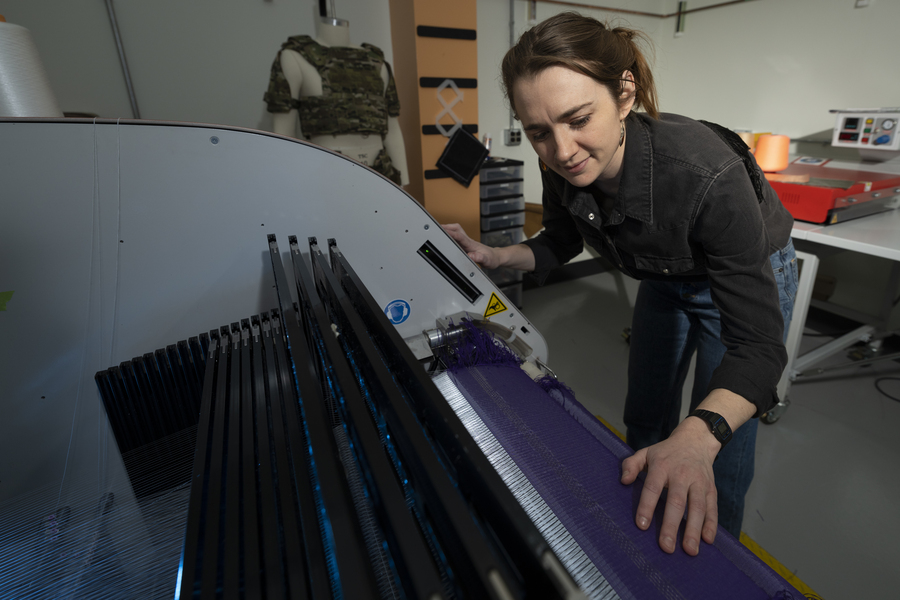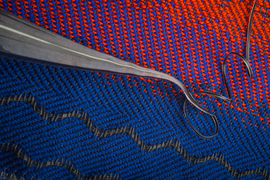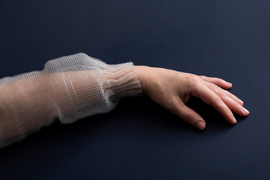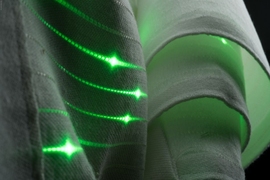In the United States, an estimated 15 million tons of textiles end up in landfills or are burned every year. This waste, amounting to 85 percent of the textiles produced in a year, is a growing environmental problem. In 2022, Massachusetts became the first state to enact a law banning the disposal of textiles in the trash, aiming to up recycling percentages.
But recycling textiles isn’t always easy. Those that can’t be resold as-is are sent to facilities to be sorted by fabric type. Sorting by hand is labor intensive, made harder by worn-out or missing labels. More advanced techniques that analyze a fabric’s chemistry often aren’t precise enough to identify materials in fabric blends, which make up most clothing.
To improve this sorting process, a team from MIT Lincoln Laboratory and the University of Michigan offer a new way to label fabrics: by weaving fibers with engineered reflectivity into them. This fiber is only reflective under certain infrared light. Depending on the wavelengths of light that the fiber reflects when scanned, recyclers would know which type of fabric the fiber represents. In essence, the fiber works like an optical barcode to identify a product.
“Having a way to easily identify fabric types and sort them as they’re coming through could help make recycling processes scale up. We want to find ways to identify materials for another use after the life cycle of the garment,” says Erin Doran, a co-author of the team’s study, which was recently published in Advanced Materials Technologies.
Pulling threads
Doran is a textile specialist at the Defense Fabric Discovery Center (DFDC) at Lincoln Laboratory. There, she works with researchers in the Advanced Materials and Microsystems Group to make “fabrics of the future” by integrating fibers ingrained with tiny electronics and sensors.
At the University of Michigan, Brian Iezzi, the study's lead author, was investigating ways to improve textile recyclability. His work in U-Michigan's Shtein Lab focuses on applying photonics to fiber-based devices. One such device is called a structural-color fiber, a type of photonic fiber first developed at MIT more than 20 years ago by Professor Yoel Fink’s research team. It’s one area of expertise today at the DFDC.
“It's a fiber that acts like a perfect mirror,” says DFDC researcher Bradford Perkins, a co-author of the study. “By layering certain materials, you can design this mirror to reflect specific wavelengths. In this case, you’d want reflections at wavelengths that stand out from the optical signatures of the other materials in your fabric, which tend to be dark because common fabric materials absorb infrared radiation.”
The fiber starts out as a block of polymer called a preform. The team carefully constructed the preform to contain more than 50 alternating layers of acrylic and polycarbonate. The preform is then heated and pulled like taffy from the top of a tower. Each layer ends up being less than a micron thick, and in combination produce a fiber that is the same size as a conventional yarn in fabric.
While each individual layer is clear, the pairing of the two materials reflects and absorbs light to create an optical effect that can look like color. It’s the same effect that gives butterfly wings their rich, shimmering colors.
“Butterfly wings are one example of structural color in nature,” says co-author Tairan Wang, also from Lincoln Laboratory. “When you look at them very closely, they're really a sheath of material with nanostructured patterns that scatter light, similar to what we’re doing with the fibers.”
By controlling the speed at which the fibers are drawn, researchers can “tune” them to reflect and absorb specific, periodic ranges of wavelengths — creating a unique optical barcode in each fiber. This barcode can then be assigned to corresponding fabric types, one symbolizing cotton, for example, and another polyester. The fibers would be woven into fabrics when the fabrics are manufactured, before being put to use in a garment and eventually recycled.
Unlike the eye-catching designs of butterfly wings, the fibers are not meant to be showy. “They would make up less than a few percent of the fabric. Nobody would be able to tell that they're there until they had an infrared detector,” Perkins says.
A detector could be adapted from the kind used to sort plastics in the recycling industry, the researchers say. Those detectors similarly use infrared sensing to identify the unique optical signatures of different polymers.
Trying it on in the future
Today, the team has applied for patent protection on their technology, and Iezzi is evaluating ways to move toward commercialization. The fibers produced in this study are still slightly thick relative to clothing fibers, so thinning them more while retaining their reflectivity at the desired wavelengths is a continued area of research.
Another avenue to explore is making the fibers more akin to sewing thread. This way, they could be sewn into a garment in cases when weaving them into a certain fabric type could affect its look or feel.
The researchers are also thinking about how structural-color fibers could help tackle other environmental problems in the textile industry, like toxic waste from dyes. One could imagine using such fibers to make fabrics that are inherently imbued with color that never fades.
“It’s important for us to consider recyclability as the electronic-textile market expands, too. This idea can open avenues for recovering chips and metals during the textile recycling process.” Doran says. “Sustainability is a big part of the future, and it’s been exciting to collaborate on this vision.”









